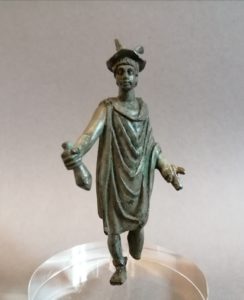May 15, the feast of Mercury

Roman merchants celebrated the Feast of Mercury on the Ides of May (the 15th day of the month).
Full cast bronze figurine datable to the end of the I century – beginning of the II century A.D.
The god Mercury is represented with a cloak fastened by fibulae on the shoulders, with a series of V-shaped folds that go down to the hem. He is characterized by the typical attributes that distinguish him: he wears a hat with two wings, the petasus, holds the winged caduceus in his left hand and a bag full of money in his right. It is a type of figurine very common in the Augustan age in northern Italy and Gaul.
The ancient Romans loved keeping the images of the deities in their homes in the Larari, altars for domestic worship where they exhibited the statuettes of the Lares and Penates: that is, those of the gods most dear to them and sometimes even of their ancestors, to whom they addressed prayers and requests for help. They were generally bronze, wooden or terracotta figurines.
In Roman religion, Mercury was the patron god of commerce, profit and travellers. The flaps on the hat are reminiscent of the corresponding Greek deity Hermes, messenger of the gods. The caduceus, the rod with two intertwined snakes and two wings, was a symbol of prosperity and peace and, later, became a symbol of medicine.
The Roman bronze is an artefact purchased for the Museum of Archaeology of the University of Pavia by the founder, Professor Pietro Vittorio Aldini, between 1821 and 1822. The site of discovery is, unfortunately, unknown. The collection of figurative bronze statuettes, like all the other finds in the museum, were acquired for the teaching of archaeology, thus allowing students to have a direct experience of the artefacts.
The Civic Archaeological Museum of Casteggio also possesses a similar find. This small bronze was found in Rivanazzano Terme and is chronologically contextual to that of Pavia.
When the two museums reopen, we will be waiting for you to admire and compare them!

Mercury from the Museum of Archaeology of the University of Pavia, photo by Davide Barbieri

Mercury from the Civic Archaeological Museum of Casteggio, photo by Valentina Dezza
